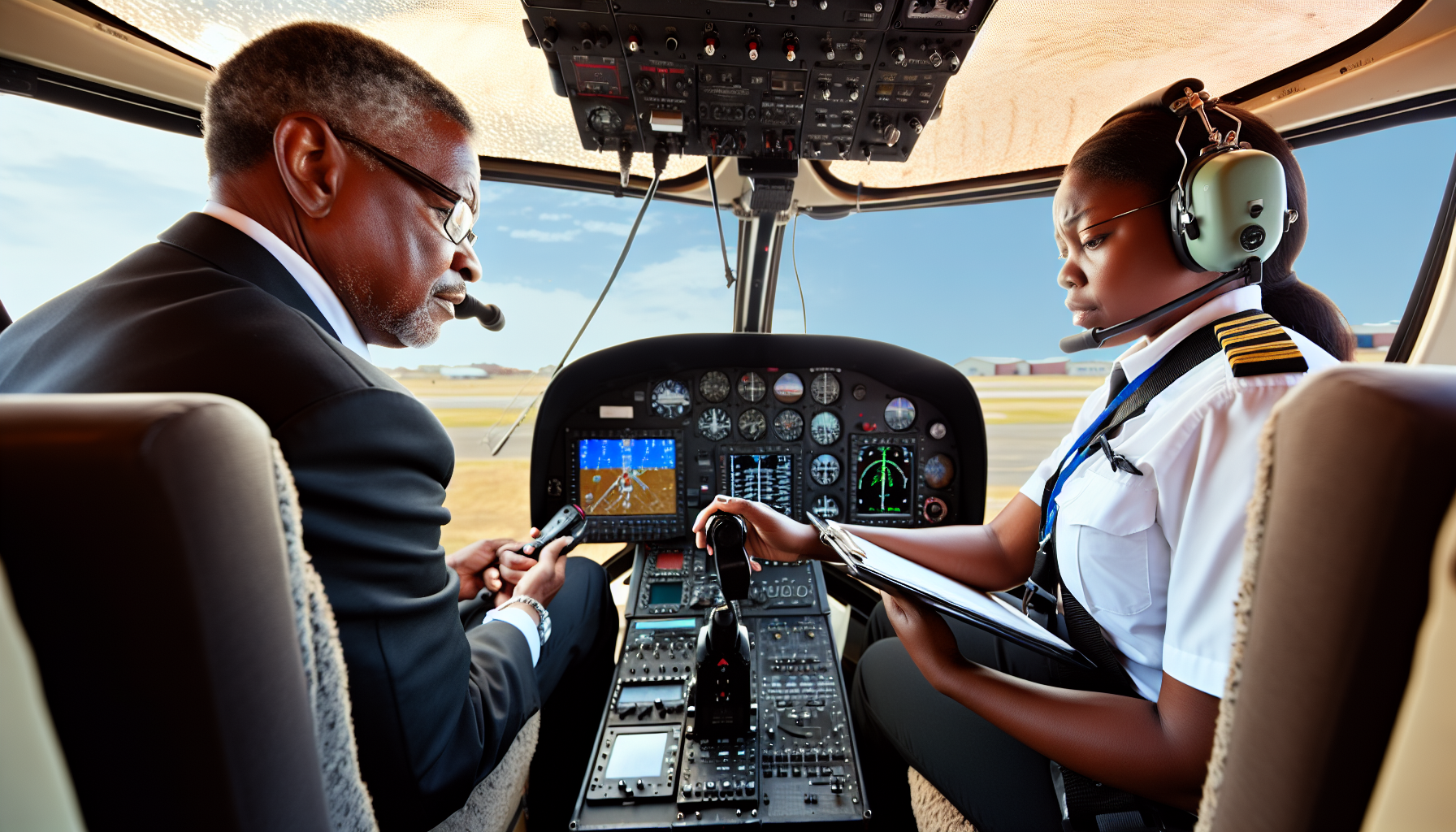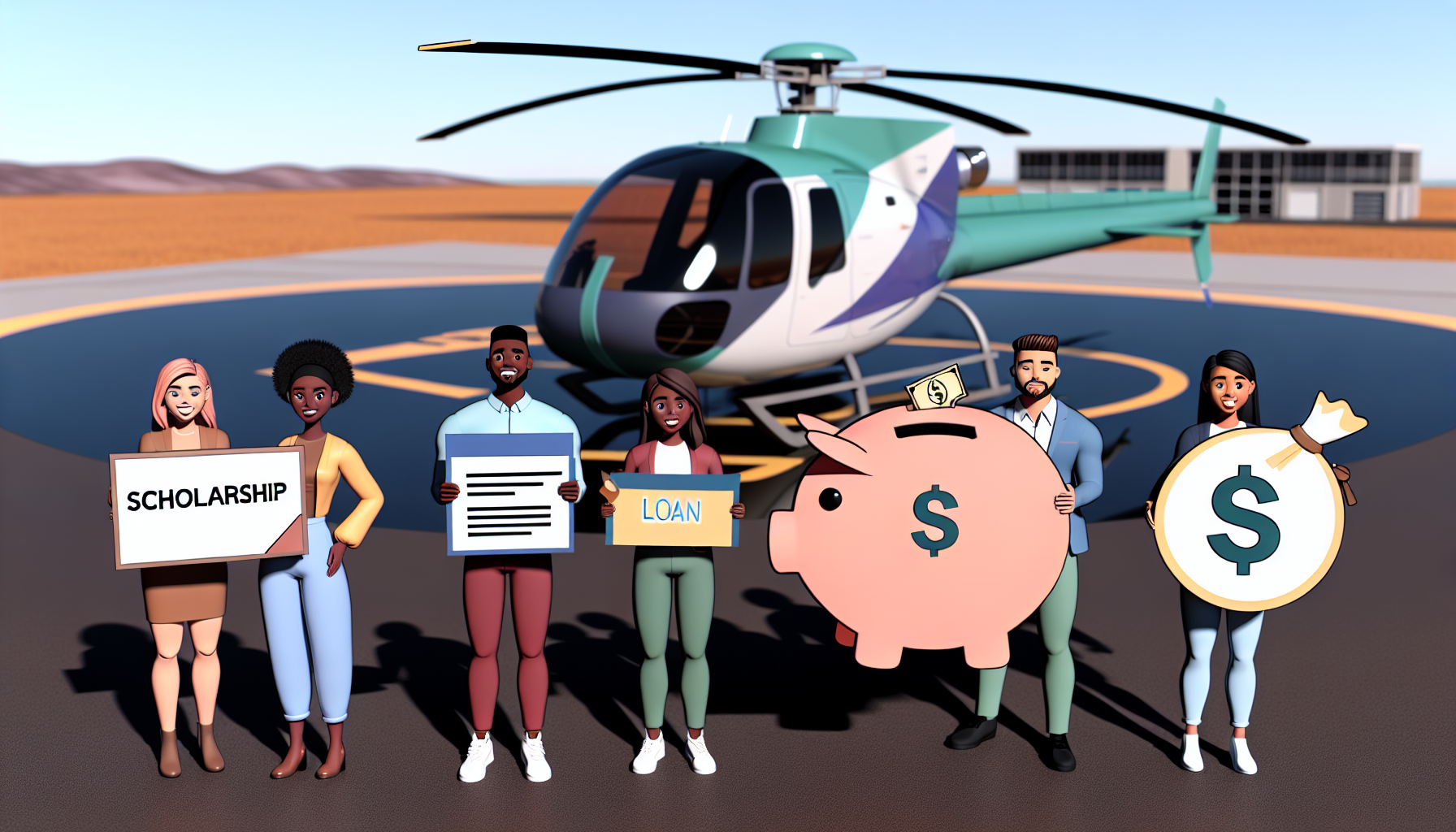Helicopter Pilot License Requirements Explained
Feb 16, 2024
Imagine the thrill of soaring through the sky, commanding the power of a helicopter at your fingertips. This dream can become a reality with the right training and certification.
But where do you start on this exhilarating journey? This blog post will guide you along the path to becoming a helicopter pilot, from understanding the different helicopter pilot license requirements and meeting eligibility criteria to selecting the right flight school and financing your training.
So, are you ready to turn your dreams of flying into reality?
Key Takeaways
-
Understand the different helicopter pilot licenses and their requirements.
-
Become a licensed pilot by meeting age, medical fitness, and flight experience criteria.
-
Maintain your license with periodic reviews and consider additional ratings for career advancement opportunities.
Understanding Helicopter Pilot Licenses

If you’re keen on soaring the skies, be aware of the various types of helicopter pilot licenses, each offering unique privileges and requirements. Whether you want to fly for fun, earn a living as a professional pilot, or teach others to fly, there’s a license tailored to your aspirations. The three primary licenses are the Private Pilot, Commercial Pilot, and Certified Flight Instructor (CFI) licenses, each demanding a distinct level of flight training. We will provide further details on each.
Private Pilot License
For many, the journey to becoming a helicopter pilot starts with the Private Pilot License. This license allows you to fly helicopters for personal use, but not for compensation or hire. It’s the perfect license if you want to fly helicopters as a hobby or for personal transportation.
Answering the question of how to get a helicopter pilot license, the FAA stipulates a minimum of 40 hours of helicopter flight training, including 20 hours of instruction and 10 hours of solo flight time. However, keep in mind that this is a minimum requirement; many pilots log more hours to become proficient.
Commercial Pilot License
If your dream is to become a commercial helicopter pilot and earn a salary, the commercial helicopter pilot license is your ticket. This license allows you to transport passengers and cargo, conduct rescue operations, and is required to become a flight instructor. To obtain this license, you need to log a minimum of 150 hours of helicopter flight time, with 100 hours as pilot-in-command and 0 hours of cross country time.
This license opens up a world of career opportunities in various industries, from emergency medical services to tourism.
Certified Flight Instructor (CFI) License
The Certified Flight Instructor (CFI) License is for those who have a passion for teaching others to fly. As a CFI, you can:
-
Instruct students working towards their private or commercial licenses
-
Share your love for flying
-
Build your flight hours
-
Earn an income
The FAA requires you to pass two written knowledge tests and demonstrate your ability to instruct students during a practical test to obtain a student pilot certificate, which is a prerequisite for this license.
Meeting the Minimum Eligibility Requirements
Before you can strap on a flight helmet and climb into the cockpit, there are a few minimum eligibility requirements you must meet. These include age, medical fitness, and flight experience. It’s essential to understand these requirements early in your journey to becoming a helicopter pilot to avoid any surprises later.
We will examine each of these requirements in detail.
Age Requirements
Age plays a significant role in pursuing a career as a helicopter pilot. The FAA requires aspiring pilots to be at least 17 years old to obtain a Private Pilot License and 18 years old for a Commercial Pilot License or a Certified Flight Instructor (CFI) License. There’s no maximum age limit, so whether you’re a fresh high school graduate or looking for a mid-career change, it’s never too late to pursue your dream of flying.
Medical Fitness
Being a helicopter pilot isn’t just about skill and knowledge; it’s also about physical health. Pilots are required to pass a flight physical examination to obtain a second-class or first-class medical certificate, which is necessary for obtaining a private pilot certificate. This examination assesses your:
-
Vision
-
Hearing
-
Balance
-
Overall physical condition
to ensure you’re fit to fly. An FAA Approved Medical Examiner (AME) conducts the examination, and pilots must renew their medical certificate every 12 months to maintain their license.
Flight Experience
Finally, before you can earn your wings, you need to log a certain number of flight hours. The exact number depends on the type of license you’re pursuing. For a Private Pilot License, the FAA requires a minimum of 40 hours of helicopter flight training, including 20 hours with an instructor and 10 hours of solo flight. These hours provide invaluable hands-on experience, allowing you to put the theoretical knowledge gained in ground school into practice.
The Training Process: Ground School and Flight Instruction

So, you’ve decided to pursue a helicopter pilot license, and you meet all the eligibility requirements. Now comes the exciting part: the training. This is where you’ll learn the ins and outs of helicopter operations, from the physics of flight to the art of navigation.
The training process is typically broken down into two main components: ground school and flight instruction. We will provide more details about these elements.
Ground School
Ground school is where you’ll gain the theoretical knowledge necessary to fly a helicopter. Here, you’ll study topics such as:
-
Aerodynamics
-
Helicopter flight controls
-
Emergency procedures
-
Aviation regulations
-
Meteorology
This classroom instruction forms the basis for all your air maneuvers, marking it as a vital part of your training.
Flight Instruction
Flight instruction is where you’ll translate the theoretical knowledge gained in ground school into practical skills. Under the guidance of an experienced instructor, you’ll learn to:
-
Handle the controls
-
Perform flight maneuvers
-
Navigate
-
Respond to simulated emergency situations
The goal of flight instruction is to help you become a safe, confident, and competent pilot.
Passing the Exams: Oral and Practical Tests

Now that you’ve completed the training, it’s time to prove your knowledge and skills. To obtain a helicopter pilot license, you must pass two types of exams: a oral exam and a practical test, also known as a check ride. Both exams are critical in demonstrating your understanding and proficiency in helicopter operations.
We will examine each of these exams thoroughly.
Oral Exam
The Oral exam for a Private Pilot License in helicopter operations is a critical step in the certification process. It's a one-on-one session with an examiner where you'll need to demonstrate a solid understanding of essential aviation knowledge. Topics include helicopter mechanics, flight planning, regulations, and responding to hypothetical emergency scenarios. It's an interactive discussion that tests your readiness for solo flight and decision-making in the air.
Practical Test (Check Ride)
The practical test, or check ride, is the final hurdle to earning your helicopter pilot license. During the check ride, you’ll demonstrate your ability to operate a helicopter safely and effectively under various conditions. The examiner will assess your skills in:
-
Pre-flight preparation
-
Performance maneuvers
-
Navigation
-
Emergency procedures
Passing the check ride is a testament to your skill and proficiency as a helicopter pilot.
Maintaining and Advancing Your Helicopter Pilot License

Once you’ve earned your helicopter pilot license, your journey doesn’t end there. To keep your license active and stay safe in the air, you’ll need to undergo periodic flight reviews. Additionally, there are numerous additional ratings and certifications you can earn to enhance your skills and open up new career opportunities.
In this article, we will discuss how to maintain and enhance your helicopter pilot’s license, including the steps for helicopter pilots to upgrade to a commercial helicopter pilot license and obtaining a helicopter pilot certificate.
Flight Review
A flight review is a periodic evaluation of your flying skills and knowledge. Required every 24 months, it involves a review of current aviation regulations and a flight with an instructor to ensure you’re still safe and competent in the cockpit.
Staying current with your flight reviews is not just a legal requirement—it’s also a good way to ensure you’re always at the top of your game.
Additional Ratings and Certifications
Whether you want to fly different types of aircraft or teach others to fly, additional ratings and certifications can help you achieve your goals. From an Instrument Rating to a Certified Flight Instructor (CFI) certification, these additional qualifications can enhance your skills, increase your employability, and open up new career opportunities.
Financing Your Helicopter Pilot Training

Becoming a helicopter pilot is an investment in your future, but it doesn’t have to break the bank. There are various funding options available to help cover the costs of your training. From loans to scholarships, we will discuss how to finance your journey to becoming a pilot.
Cost Breakdown
The cost of helicopter pilot training can vary depending on the type of license you’re pursuing and the flight school you choose. Costs include:
-
Flight hours
-
Ground school
-
Testing fees
-
Equipment
By understanding the breakdown of these costs, you can budget more effectively and find the best way to finance your training.
Funding Options
There are several ways to fund your helicopter pilot training. Personal savings, loans, and scholarships are some of the most common. Some flight schools even offer their own financing options.
With some research and careful planning, you can find a funding option that works for you.
Choosing the Right Flight School
The flight school you choose can have a significant impact on your training experience and future career. It’s important to choose a school that offers high-quality instruction, modern facilities, and a strong reputation in the industry.
We will consider some factors in choosing a suitable flight school.
Accreditation and Reputation
Accreditation and reputation are important indicators of a flight school’s quality. Accreditation ensures the school meets certain standards of quality and accountability, while a good reputation indicates the school’s track record of producing competent pilots.
Investigating a school’s accreditation and reputation can aid you in making a sensible choice.
Training Programs and Facilities
The quality of the training program and the facilities at a flight school are crucial factors to consider. A good training program will provide:
-
Comprehensive instruction
-
Theoretical knowledge
-
Practical flight training
-
Experienced instructors
Modern facilities will provide the resources you need to succeed.
Summary
To sum up, becoming a helicopter pilot is a journey that involves meeting eligibility requirements, choosing the right flight school, and completing comprehensive training. Along the way, you’ll need to pass written and practical exams, maintain your license through regular flight reviews, and potentially pursue additional ratings and certifications. Whether you dream of flying for pleasure, as a career, or teaching others, the sky’s the limit when it comes to the opportunities that await you as a helicopter pilot.
Frequently Asked Questions
What are the requirements for a helicopter pilot?
To become a helicopter pilot, one must obtain a pilot license by passing an FAA medical examination, completing ground school courses, and obtaining the required flight hours with an instructor. Additionally, applicants must pass a written exam and an oral check-ride with an FAA designated examiner.
What disqualifies you from being a helicopter pilot?
Being medically disqualified from being a helicopter pilot is a possibility due to weight limits, inner ear conditions, coronary artery disease, chronic headaches, decompression sickness, poor hearing, bad vision, allergies, cardiovascular or neurological disorders, substance abuse or dependency, and personality, psychosis, alcoholism, drug dependence, epilepsy, unexplained disturbances of consciousness, myocardial infarction, angina pectoris, and diabetes requiring medication for its control.
Is it harder to get a helicopter or plane license?
Ultimately, getting either a helicopter or plane license depends on personal preference and financial situation. Neither option is inherently more difficult than the other; both paths have their own unique challenges and rewards.
What are the different types of helicopter pilot licenses?
There are three main types of helicopter pilot licenses: Private Pilot License, Commercial Pilot License, and Certified Flight Instructor (CFI) License, each with its own privileges and requirements.
What does helicopter pilot training involve?
Helicopter pilot training combines theoretical knowledge and hands-on practice to prepare aspiring pilots for safe, successful flights. Ground school covers the necessary theoretical knowledge while flight instruction provides the practical experience required to fly a helicopter.
